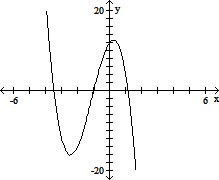Two sides and an angle are given. Determine whether the given information results in one triangle, two triangles, or no triangle at all. Solve any triangle(s) that results.b = 3, c = 4, B = 65°
A. one triangle
B = 33°, A = 82°, a = 7
B. one triangle
C = 34°, A = 81°, a = 11
C. one triangle
C = 32°, A = 83°, a = 9
D. no triangle
Answer: D
Mathematics
You might also like to view...
Solve the problem.In a complete graph with 16 vertices (A through P), the total number of Hamilton paths that start at vertex A and end at vertex P is
A. 17!. B. 15!. C. 14!. D. 16!. E. none of these
Mathematics
Simplify.
A. 7k7q8
B. 7q4
C. 7k3q4
D. 7k3q4
Mathematics
Find the equation that the given graph represents.
A. f(x) = -3x3 - 10x2 + 5x + 12 B. f(x) = 2x3 - 12x2 - 5x - 12 C. f(x) = x4 - 2x2 - 3x + 12 D. f(x) = 3x2 - 5x + 12
Mathematics
Decide whether the equation defines y as a function of x. (Remember that to be a function, every value of x must give one and only one value of y.)y2 = (x - 9)(x + 7)
A. No B. Yes
Mathematics